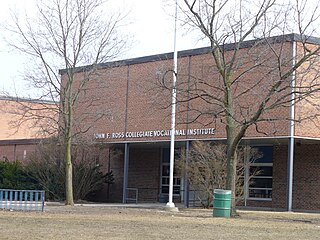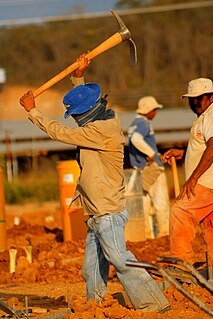
The Office of Management and Budget (OMB) is the largest office within the Executive Office of the President of the United States (EOP). OMB's most prominent function is to produce the President's Budget, but OMB also measures the quality of agency programs, policies, and procedures to see if they comply with the president's policies and coordinates inter-agency policy initiatives.

Vocational education is education that prepares people to work as a technician or in various jobs such as a trade or a craft. Vocational education is sometimes referred to as career education or technical education.
A vocational school is a type of educational institution specifically designed to provide vocational education.

A system administrator, or sysadmin, is a person who is responsible for the upkeep, configuration, and reliable operation of computer systems; especially multi-user computers, such as servers. The system administrator seeks to ensure that the uptime, performance, resources, and security of the computers they manage meet the needs of the users, without exceeding a set budget when doing so.

A tradesman, tradeswoman, tradesperson, skilled tradesman, skilled tradeswoman, skilled tradesperson or tradie refers to a worker who specializes in a particular occupation that requires work experience, on-the-job training, and often formal vocational education, but not a bachelor's degree.

A blue-collar worker is a working class person who performs manual labor. Blue-collar work may involve skilled or unskilled manufacturing, mining, sanitation, custodial work, textile manufacturing, power plant operations, farming, commercial fishing, landscaping, pest control, food processing, oil field work, waste disposal, and recycling, electrical, plumbing, construction, mechanic, maintenance, warehousing, shipping, technical installation, and many other types of physical work. Blue-collar work often involves something being physically built or maintained.
A white-collar worker is a person who performs professional, managerial, or administrative work. White-collar work may be performed in an office or other administrative setting. White-collar includes business management, customer support, market research, finance, engineering, operations research, marketing, information technology, networking, attorneys, medical professional, public relation, talent professionals, architects, graphics design, stockbrokers, accounting, auditor, actuary, customs professional, research and development and contracting. Other types of work are those of a blue-collar worker, whose job requires manual labor and a pink-collar worker, whose labor is related to customer interaction, entertainment, sales, or other service-oriented work. Many occupations blend blue, white and pink (service) industry categorizations.

Occupational therapy (OT) is the use of assessment and intervention to develop, recover, or maintain the meaningful activities, or occupations, of individuals, groups, or communities. It is an allied health profession performed by occupational therapists and Occupational Therapy Assistants. OTs often work with people with mental health problems, disabilities, injuries, or impairments.
A United States military occupation code, or a military occupational specialty code, is a nine-character code used in the United States Army and United States Marine Corps to identify a specific job. In the United States Air Force, a system of Air Force Specialty Codes (AFSC) is used. In the United States Navy, a system of naval ratings and designators are used along with the Navy Enlisted Classification (NEC) system. A system of ratings are also used in the United States Coast Guard.
The Standard Occupational Classification (SOC) System is a United States government system of classifying occupations. It is used by U.S. federal government agencies collecting occupational data, enabling comparison of occupations across data sets. It is designed to cover all occupations in which work is performed for pay or profit, reflecting the current occupational structure in the United States. The 2010 SOC includes 840 occupational types.
A clerk is a white-collar worker who conducts general office tasks, or a worker who performs similar sales-related tasks in a retail environment. The responsibilities of clerical workers commonly include record keeping, filing, staffing service counters, screening solicitors, and other administrative tasks.
A Medical Assistant, also known as a "Clinical Assistant" or healthcare assistant in the UK is an allied health professional who supports the work of physicians and other health professionals, usually in a clinic setting. Medical assistants can become certified through an accredited program. Medical Assistants perform routine tasks and procedures in a medical clinic.
The Michigan Occupational Safety and Health Administration (MIOSHA) is a state government agency that regulates workplace safety and health in the U.S. state of Michigan. Michigan OSHA is an agency within the Michigan Department of Licensing and Regulatory Affairs (LARA) and operates under a formal state-plan agreement with the Occupational Safety and Health Administration (OSHA).
Office administration is a set of day-to-day activities that are related to financial planning, record keeping & billing, personnel, physical distribution and logistics, within an organization. An employee that undertakes these activities is commonly called an office administrator or office manager, and plays a key role in any organizations infrastructure, regardless of the scale. Many administrative positions require the candidate to have an advanced skill set in the software applications Microsoft Word, Excel and Access.
A biomedical engineering/equipment technician/technologist or biomedical engineering/equipment specialist is typically an electro-mechanical technician or technologist who ensures that medical equipment is well-maintained, properly configured, and safely functional. In healthcare environments, BMETs often work with or officiate as a biomedical and/or clinical engineer, since the career field has no legal distinction between engineers and engineering technicians/technologists.
Transferable skills analysis is a set of tests or logic to determine what positions a person may fill if their previous position(s) no longer exists in the local job market, or they can no longer perform their last position(s). An informal transferable skills analysis can be performed with the help of a career counselor, career portfolio or a career planning article or book. Transferable skills are determined by analyzing past accomplishments or experience. For instance, a stay-at-home parent and homemaker might find they have skills in budgeting, child development, food services, property management, and so on.

National Park Service rangers are among the uniformed employees charged with protecting and preserving areas set aside in the National Park System by the United States Congress and the President of the United States. While all employees of the agency contribute to the National Park Service mission of preserving unimpaired the natural and cultural resources set aside by the American people for future generations, the term "park ranger" is traditionally used to describe all National Park Service employees who wear the uniform. Broadly speaking, all National Park Service rangers promote stewardship of the resources in their care - either voluntary stewardship via resource interpretation, or compliance with statute or regulation through law enforcement. These comprise the two main disciplines of the ranger profession in the National Park Service.
Groups of working individuals are typically classified based on the colors of their collars worn at work; these can commonly reflect one's occupation or sometimes gender. White-collar workers are named for the white-collared shirts that were fashionable among office workers in the early and mid-20th century. Blue-collar workers are referred to as such because in the early 20th century, they usually wore sturdy, inexpensive clothing that did not show dirt easily, such as blue denim or cambric shirts. Various other "collar" descriptions exist as well.
Human resource management in public administration concerns human resource management as it applies specifically to the field of public administration. It is considered to be an in-house structure that ensures unbiased treatment, ethical standards, and promotes a value-based system.
The Worker Protection Standard is intended to protect employees on farms, forests, nurseries, and greenhouses that are occupationally exposed to agricultural pesticides.








